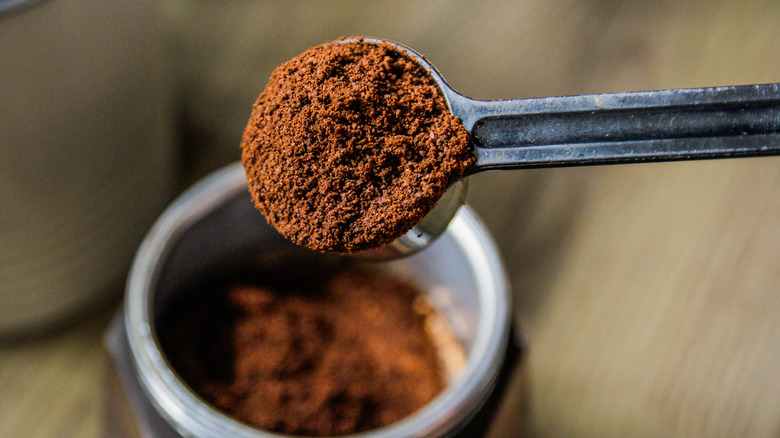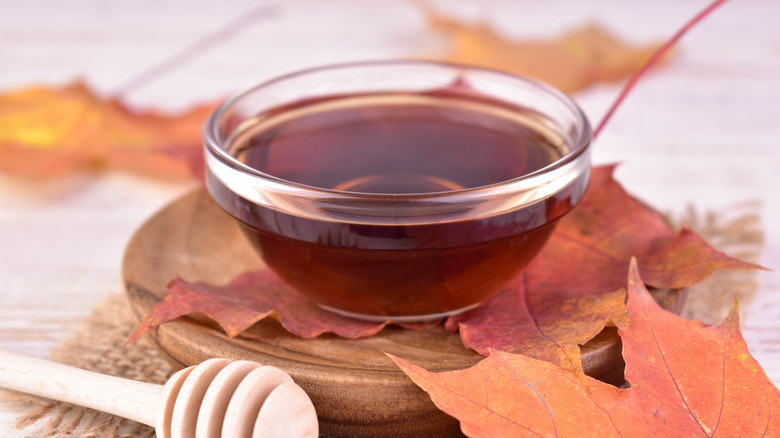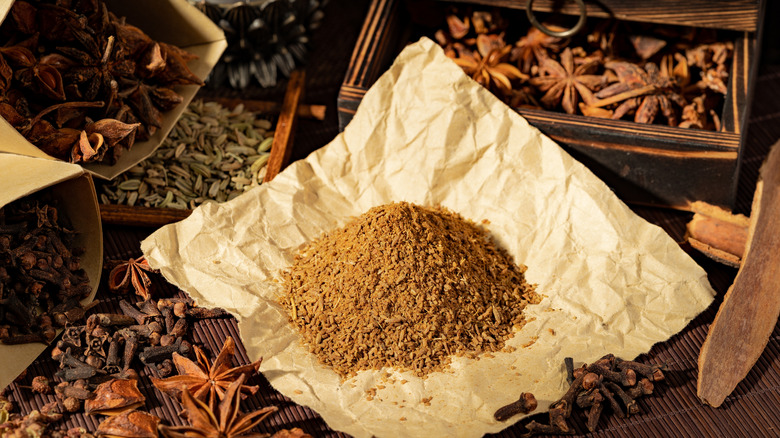16 Ingredients To Elevate Homemade Gingerbread Cookies
The transition from fall to winter isn't just about a drop in temperature or swapping out your leaf and pumpkin decor for nutcrackers and cheesy "Let it snow" pillows. It's also about transitioning the recipes you're baking in your kitchen. While the fall months are all about pumpkin and apple everything, the winter often takes on more hearty and seasonally relevant bakes — including the beloved gingerbread cookie.
Gingerbread cookies can take many forms. Most commonly, though, they are rolled out in a sheet and cut into cute shapes (including the aptly named gingerbread man), or they can be used for constructing a fun and festive gingerbread house. Regardless of the website or cookbook that you're using for your recipe, you'll find several common ingredients: brown sugar (to keep the dough moist and sweet), molasses (for color and flavor), and spices (the most pertinent of which is dried ginger), along with your classic cookie ingredients like flour and leavening agents.
But, as a home baker who loves experimenting with recipes like gingerbread, I've found so many ways and ingredients that can build off the flavor of the classic gingerbread recipe and transform it into something new. The next time you're looking for an inventive way to switch up the classic recipe, try one (or more) of these ingredient additions.
Black pepper
If you are someone who is unfamiliar with savory bakes, the thought of using black peppercorns in a recipe can be a little bit off-putting. After all, you usually only see them as the crust on the outside of a steak or as a flavorful addition to pasta. But, the spicy bite of black pepper makes it an excellent addition to your next batch of gingerbread cookies, too. Not only will the black pepper cut through the richness of your dough, but it will also balance out the sweetness and complement the other warming spices in your batter quite well.
The key to adding black pepper is to freshly crack it into your bowl while you're mixing in the rest of the spices. Don't settle for the finely ground canned pepper that you may find in the grocery store. Opt for a larger flake so that you get a surprising pop or flavor rather than one that gets muddled by the other warming spices.
Espresso powder
You may like drinking spiced lattes during the fall and winter months, but it might seem a bit odd to add a dash of espresso powder to your gingerbread cookie recipe. This powder, which can be substituted for instant coffee granules, is full of punchy coffee flavor and won't water down your dough like adding a shot or two of liquid espresso or strong coffee would.
The espresso flavor is one that works really well with cinnamon and ginger, which is why I would recommend adding the powder to a gingerbread cookie recipe. You'll only need a couple of tablespoons to add some extra oomph to your dough; be sure to mix it in well so that the flavor is distributed throughout it. Moreover, you can also pair espresso powder with other additions, like cocoa powder or chai spices, for a more complex profile.
Cayenne pepper
Some like it hot, and for them, there is cayenne pepper. This spice doesn't skimp out on the heat, but I find that it has a more profound warming flavor to it than other, more abrasive spices. This means that it's a shoo-in for pairing with cloves, ginger, and the overly sweet additions of molasses and brown sugar.
As with any hot spice, you should add it incrementally to your baked goods. Although it might seem a bit trivial to add a mere ¼ teaspoon to a recipe that makes two dozen cookies, you'll thank yourself (and your light hand) later. Too much of this spice will shift the balance of your cookies to something too hot and overwhelming.
Orange zest
Orange and ginger are a fantastic combination. The bright flavor of the citrus meshes well with the warming and wholesome flavor of the gingerbread cookie, which makes every bite feel complete and not at all heavy.
I would recommend that folks add orange zest to their gingerbread cookies because the citrus will add that slightly zesty bite to the dough. It's not a flavor that can be recreated by anything else but fresh orange zest. You can add the zest of a whole orange straight into the batter with the butter and the sugar. As with all citrus fruits, make sure you only zest the fruit's skin rather than going too far into the pith. Otherwise, you'll end up with a bitter flavor.
If you want the orange flavor to really shine, I would recommend chilling your dough for as long as you can while you prepare your oven and get your cookie cutters out. Letting cookie dough rest helps it taste better because the moisture in the dough will evaporate as it sits in the fridge, thus concentrating sweet, bitter, and salty flavors.
Cream cheese
Cream cheese is probably not an ingredient that comes to mind when you think of gingerbread cookies. Though, it can be a great addition to your recipe, especially when you're craving a soft cookie (in other words, not a gingersnap), because of its high fat content. I also add cream cheese to my sugar cookie dough because I find the tanginess to be a great complement to the sweetened dough.
Besides creaming the block directly into your dough, you can also create fun renditions of the classic gingerbread cookie using a block of cream cheese. For one, you may want to whip it up with an egg yolk and sugar and mold it into the center of your cookies for an unexpectedly soft bite. Or, you can whip up a simple cream cheese frosting to serve on top of your cookies; the tangy yet sweet icing is a great complement to the warmly spiced cookies underneath.
Ground coriander
Coriander is a spice that you are likely more familiar with using in savory meals rather than sweet bakes. But, that doesn't mean that this spice doesn't have a place in your gingerbread cookies, too. I like using coriander in a gingerbread recipe because I find that it has a really bright flavor — one that is easily complemented by the punchy taste of ground ginger. Moreover, coriander and orange zest are a great combination because each one plays off the zestiness of the other.
Like the other "heavy" spices on this list, including cayenne, you'll really want to limit how much coriander you add to your recipe. Too much can flip the flavor of your cookies into something that's oddly grassy and tart. Stick to adding no more than ¼ teaspoon into your dough. Don't worry; you'll still be able to taste its slightly citrusy flavor.
Candied or fresh ginger
Ground ginger is usually the go-to for making gingerbread cookies. There are several reasons for this — mainly that it's shelf-stable and because powdered ginger has a stronger flavor than fresh. But that doesn't mean you can't grate the root for an extra ginger emphasis in your recipe.
Grab a small knob of ginger to grate into your dough. You'll first need to remove the peels (the easiest way is with a spoon) before you can get to work. The ginger will be a little bit wet, but don't fret; it shouldn't be enough water to mess with the moisture ratio of your dough.
You can also use another type of ginger to add more flavor to your recipe: candied ginger. The candying process replaces some of the bite of ginger with sweetness, though there is still a discernible ginger flavor within the cookies. You can stir in this ginger after your dough has come together; just be wary that your finished cookies will have little bits of gumminess to them due to the candied ginger's texture. As a result, it's not an add-in I would recommend using for a roll-out-and-cut dough, as you may find the bits to be distracting.
Brown butter
Almost every baked good can be improved with the flavor of brown butter. For those unfamiliar, browning butter refers to the process of toasting the milk solids over low and steady heat. Not only will the fat start to take on a delicious, hazelnut-like flavor, but the aroma of the entire baked good will transform into something more nutty and complex. As a result, brown butter is a great addition to cookies, and gingerbread cookies in particular. Its toffee-like flavor is in perfect company with the warming ginger, cinnamon, and cloves.
Unfortunately, you can't just add the brown butter straight into your cookie dough, especially if your recipe calls for you to cream softened butter with sugar to assemble the base of the recipe. Using melted butter here will alter the consistency of your dough, and if it's too hot, it may scramble your eggs on contact. Instead, you'll want to chill your brown butter so that it hardens, then use it as you normally would in your recipe.
Whole wheat flour
All-purpose flour is a mainstay for bakers everywhere. But, it does very little by way of flavor, especially when it comes to recipes with flavor-heavy ingredients like molasses and dried ginger. To add a more rustic and nutty flavor to my gingerbread, I'll occasionally add a mix of whole wheat and white flour instead of just plain white flour.
The gluten content between these two flours is trivial (especially compared to bread flour or cake flour), so you won't have to alter too much of your recipe in order to accommodate it. However, I like to use a 50/50 ratio between these two flours because I find that the all-purpose flour gives the dough that lightness, while the whole wheat flour delivers a more hearty mouthfeel. It's the best of both worlds.
Maple syrup
Maple syrup is a far more flavorful sweetener than classic sugar or brown sugar, which is why I would recommend adding it to your next batch of gingerbread cookies. The oaky flavor is an excellent equalizer for the sharpness of the molasses and warmth of the spices. However, you have to be very careful when you introduce a liquid sweetener into your recipe. Not only can it make your dough too wet, but the added sugar content can also cause your gingerbread to burn faster.
For these reasons, I would recommend using a gingerbread recipe that is specifically designed with maple syrup in mind. These recipes will also calibrate and account for any other sweeteners that you use, like honey or brown sugar, to prevent your cookies from coming out overly sweet (because, yes, there is such a thing). Moreover, if you consider yourself to be overly wary about how your cookies bake (and, like me, you sit in front of your oven to catch the burn before it happens), you may want to try adding a few teaspoons to your icing or frosting instead.
Corn syrup
Believe it or not, there are so many ways to use corn syrup that's not just for pecan pie. One of these is in cookies.
Adding corn syrup to your batter will ensure that your cookies come out ultra-chewy. Since corn syrup is made from invert sugar, it won't harden and crystalize as your cookie cools. Corn syrup will also take up the moisture from your surrounding dough, thus ensuring that it comes out of the oven perfectly soft, decadent, and chewy. While this is not the perfect formula for a gingersnap cookie or one you plan on constructing your seasonal gingerbread house with, it does make an excellent cookie for snacking and dipping into a cold glass of milk.
Corn syrup is often used in gingerbread recipes as a replacement for molasses, the latter of which has a sharper and more sulfuric flavor. While I won't be a purist about whether or not you should use molasses in your gingerbread cookies, I will say that the flavor of a molasses-based one is more acquired, which means that corn syrup-based cookies may be a bit more approachable — especially if you're serving them to kids.
Chinese five-spice powder
If there is a spice blend that I have come to know and love over the years, it's Chinese five-spice powder. It's not a mixture that you can find in every grocery store, but if you can get your hands on it, it's certainly an ingredient worth buying. Most five-spice blends are made with usual gingerbread suspects, like cinnamon and cloves, but you can also expect a bold punch from three other additions: star anise, Sichuan peppercorns, and fennel seeds. Granted, since this spice blend is missing the ground ginger that makes gingerbread, well, gingerbread, you'll need to add it in. But otherwise, this spice blend checks the boxes for sweet, spicy, and savory.
If I'm baking gingerbread with five-spice powder, I find that I often have to add more cinnamon in to help push those sweet notes, too. Moreover, the spiciness of the peppercorns and the savory, licorice undertones of both the fennel seeds and the anise will be tempered with the rest of the ingredients — so long as you only use a little bit in your recipe. This is not one spice blend that you want to be heavy-handed with.
Cocoa powder
Chocolate and ginger go remarkably well together, despite the fact that there are very few desserts that mesh the two together. But when you're baking a batch of cocoa powder-infused gingerbread, you have the power to make magic happen.
The flavor of your gingerbread should, of course, be ginger, which is why I wouldn't recommend adding melted chocolate to the cookie dough. But, a little touch of cocoa powder can help bring out some nuances in your dough and make it all the more flavorful without going too far overboard. You'll want to use unsweetened cocoa powder in your recipe to ensure that you don't mess with the sweetness that's already present. Moreover, you should always use Dutch-processed cocoa powder over natural cocoa powder. The Dutch-processed cocoa powder will not react with the leaveners in your dough, while natural cocoa powder may cause your cookies to puff up even more — which could spell disaster for a cut-out gingerbread cookie or a gingerbread house recipe.
Sourdough starter
A solid sourdough starter can alter the flavor of your bread from bland to tangy and boring, so it's not unreasonable to see how it can upgrade your cookie recipe, too. Make no mistake, adding some of your leftover sourdough discards will not turn your cookie recipe into a loaf of well-risen bread, but it will add a stronger tang and depth of flavor than you may have thought was possible.
In general, sourdough is a great addition to chewy gingerbread cookies, but not necessarily the snappy variety used for constructing gingerbread houses. However, a discard-infused dough will still be malleable enough to cut out into your favorite cookie shapes. Add in a little bit of your sourdough discards, or an active, well-fed starter, and let your dough rest in the fridge for a little bit before rolling it out and preparing it. The longer you leave your dough in the fridge, the more flavorful it will become, as the yeasts will have longer to interact with the flour, sugars, and other ingredients.
Vanilla bean paste
Vanilla extract is a common addition to gingerbread cookies. It's a pantry staple and one ingredient that you'll likely already have on hand if you bake anything sweet. But, your gingerbread (as well as any cookie recipe, really) is begging you to take the jump and buy a jar of vanilla paste to use instead. Unlike extract, which is made by soaking the pods in alcohol, vanilla paste is made with scrapings from the actual pods. So, not only will you get those satisfying tiny specks of vanilla in your cookies, but you will get a better, more pronounced vanilla flavor.
Vanilla is in good company with all of the warming spices in gingerbread. So, even if you can't see the specks of vanilla against the brown cookie, you can definitely taste the difference. It's important to note that a jar of quality vanilla paste, like this one from Nielsen-Massey, is more expensive than standard vanilla extract. Still, if you bake enough, it's one ingredient I recommend keeping on hand at all times.
Chai spices
I've never been the type of person to drink chai, but I've found a lot of promise in the spicy tea's potential as an addition to baked goods. Typically, chai spices contain cinnamon, ginger, allspice, cloves, nutmeg, and cardamom. Several of these spices are already great additions to gingerbread; I find that the cardamom has a particularly compelling flavor that will give your cookies a little more complexity. Moreover, if you're just starting to experiment with spice blends and baking, adding chai spices to your gingerbread is where you'll want to start. Unlike five-spice powder, there are no spicy or savory elements here that you have to be wary of. So, chai spices tend to be a bit more forgiving when you add them heavy-handedly to your dough.
As with other spices on this list, you're going to want to add extra dried ginger to your recipe to make it into a true gingerbread. But the balance of spices already in this blend offers a distinct, creative addition to your cookies that won't make you stretch too far outside of your comfort zone.
















